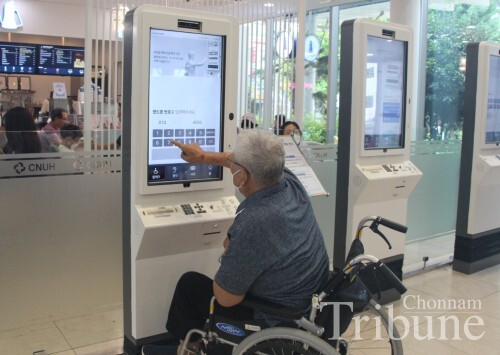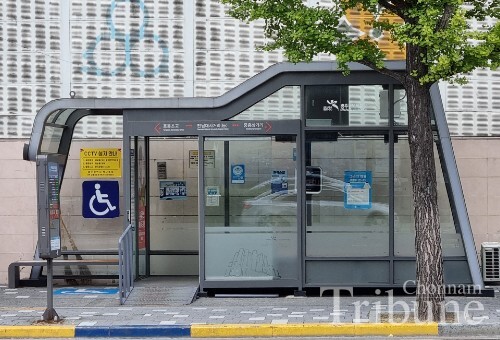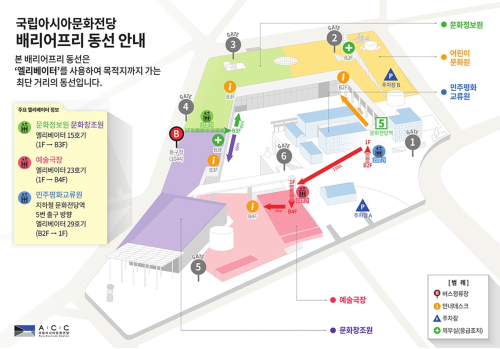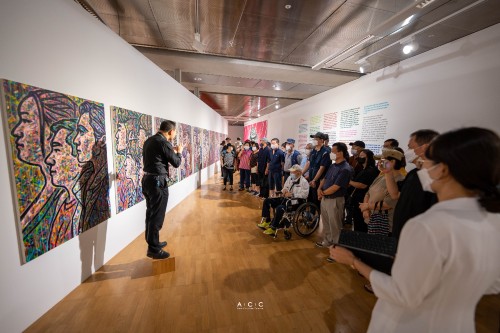
“Woo to the Young to the Woo” and “Dong to the Geu to the Ra-mi.” These are the signature greetings from the drama “Extraordinary Attorney Woo” that is a big hit around the world and is considered the next “Squid Game” on CNN business. The success of the drama draws attention to people with disabilities. It is not the first time a person with a disability has appeared in the media, but the drama makes people become interested in equality and the problems of the disabled. Naturally, many of these people are now paying attention to barrier-free environments and a mindset for everyone. Many changes are still needed to guarantee the basic human rights of disabled people including the right to mobility. However, a variety of facilities and institutions have been improved with barrier-free features compared to the past. The Chonnam Tribune looked at recommended barrier-free cases towards an inclusive society across the country.
Moving from Place to Place
The right to mobility is one of the fundamental rights for every person. If it were not guaranteed, we would not be able to do anything by ourselves. In Korea, there have been institutional changes and facilities for persons with disabilities to guarantee their mobility rights. We can see braille paving blocks and ramps on the street, and parking spaces for them commonly. In addition, call taxis and low-floor buses are examples of public transport that is accessible for them. The users only have to pay for the minimum fare and usage fee, and then the local government pays the difference for them. This system reduces the cost burden on the disabled. There is a company that makes an auxiliary power unit for lowering the cost burden. Todo Works, established in 2016, is a social startup to improve mobility for children using a wheelchair. They developed light and small wheelchairs that have power assistance, which also have a competitive price. Those are the start toward a more accessible and barrier-free society.

Since they were introduced in the early 2000s, low-floor buses have an average distribution rate of 30-40% compared to regular city buses. More low-floor buses will be added, and furthermore, shuttle buses for farming and fishing villages will be introduced with a low-floor from January next year if the current buses get scrapped. However, there are still many voices for the number and operating time of the call taxis and low-floor buses to be increased. Jin Geun, chairman of the Gwangju Federation of Organizations for Differently Abled, said “There is a lot of effort currently being made to make a barrier-free society where disabled and non-disabled people live together. But Korea still lacks barrier-free facilities compared to Northern European countries. It is late to take an interest in building barrier-free environments considering Korea is a developed country. The moment for barrier-free has not arrived in our country. We look forward to helpful and barrier-free inclusive institutions for all people.”
Accessing Information
Everyone has the right to access information so that he/she can move from place to place, communicate and make decisions in their daily lives. There are a variety of facilities and devices to guarantee the rights of people with disabilities, such as braille guidance maps, closed captions, sign language interpretation, screen reader software, and alternative text. Particularly, social media platforms, which are a primary channel of communication and trend spread, provide alternative text writing services to improve web accessibility for the visually impaired. Alternative text that gives detailed descriptions of an image make screen readers read the texts. It is crucial for people with visual disabilities to obtain information from materials such as website visuals, social media posts and educational documents. Currently, several platforms, including Instagram, Facebook, Twitter, and Naver blog, provide this service to make an accessible barrier-free environment. Many media also make their digital content accessible to the disabled by using alternative text. All digital content, now, is required to be accessible to all people. In the web environment, it is compulsory to ensure access to information and reduce the digital divide regardless of disabilities. These are important steps toward ensuring the rights of people with vision-related disabilities.

These days, we can see many kiosks at places including ticket offices, cafes and restaurants. More kiosks will be installed to reduce labor costs. But, they are a little high for children and wheelchair users, and their letters are too small for elderly people. Visually impaired people cannot use them without other’s assistance. A barrier-free kiosk solves these problems, which allows users to control its height and it also has a braille guide with voice support. Yet, the barrier-free kiosks have been installed in very few places. The Chonnam National University Hospital has three barrier-free kiosks at the reception desk on the first floor of the main ward. At this spot, all people can use these kiosks to receive medical treatment at the hospital. Jang Chang-gil, a staff member who helps patients use the kiosks, said, “The barrier-free kiosk is useful because its height can be easily adjusted according to the user’s needs. But it is necessary for some people to help the old and the disabled.” There are many improvements on barrier-free facilities these days. It is important, but still, we need to try to invent even better systems and skills for a barrier-free and inclusive environment and better future.
Enjoying Culture
People consider enjoying culture as a very important factor that determines life satisfaction. Every person has the right to benefit from participating in a variety of cultural activities. It is crucial to improve the quality of life which can be tedious. Therefore, our society has made a lot of effort to guarantee the rights of people with disabilities to take part in cultural life. Disabled-friendly seats in theaters, barrier-free film festivals and subtitles for movies are some examples. But, visually impaired people are still finding it hard to see the screen of the movie and the hearing impaired cannot understand what characters in films say without subtitles.

Here are some measures implemented for them. Some platforms such as Netflix and YouTube, which can turn your home into a theater, are providing subtitle features and audio description services. They contain actors’ gestures, facial expressions, clothes, and transformations of the background. Netflix provides the services in up to 36 languages. The Korean thriller movie “Time to Hunt” adopted the audio description produced by the Korea Blind Union. Although there are 73 theaters that screen barrier-free movies in Korea, the number of available theaters is still too few. To improve cultural environments, governments and organizations have endeavored to ensure the right of unlimited access to culture.
There are barrier-free exhibitions where the disabled can enjoy artworks, and some museums have enhanced the environment for tourism. The National Museum of Korea provides assistance to help visually impaired and hearing impaired people enjoy artworks in its exhibitions. Audio guidance is also provided with explanations of the painters, colors, and figures in the paint or the used techniques. The museum uses light to help people feel paintings as vividly as tactile exhibits, as light is an important tool to express the wave of sound. The National Museum of Modern and Contemporary Art of Korea also runs a program for people with disabilities to appreciate artworks in September. In Gwangju, the Asia Culture Center has been providing barrier-free exhibitions and performances with a sign language interpreter and voice guidance for a few years. Likewise, many museums and cultural facilities try to increase the cultural accessibility of the disabled.
Creating an Inclusive Society for Everyone
Until now, different groups and individuals, including the central government and local governments, have made an effort to build a barrier-free society. They have introduced convenient and accessible facilities and institutional systems for people with disabilities to live their lives without obstacles. The cases mentioned above show that we are getting closer to a barrier-free society. If we keep trying to promote barrier-free environments, we can build an inclusive society beyond a barrier-free society, where everyone can live without obstacles or discrimination regardless of gender, age, or disability. Let’s find out about these barrier-free facilities, technologies and services around us. It seems to be a good step towards a barrier-free and inclusive society. We should remember the proverb “A good beginning is half the battle.” We can win the battle with the goal: Barrier-free.
By Lee Da-hyeon, Student Editor

